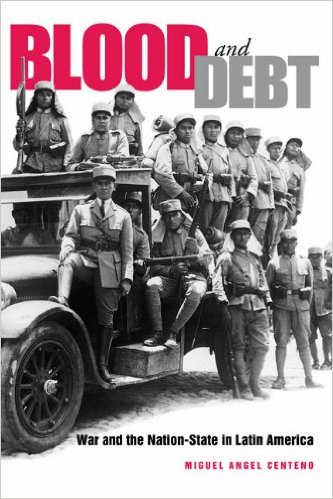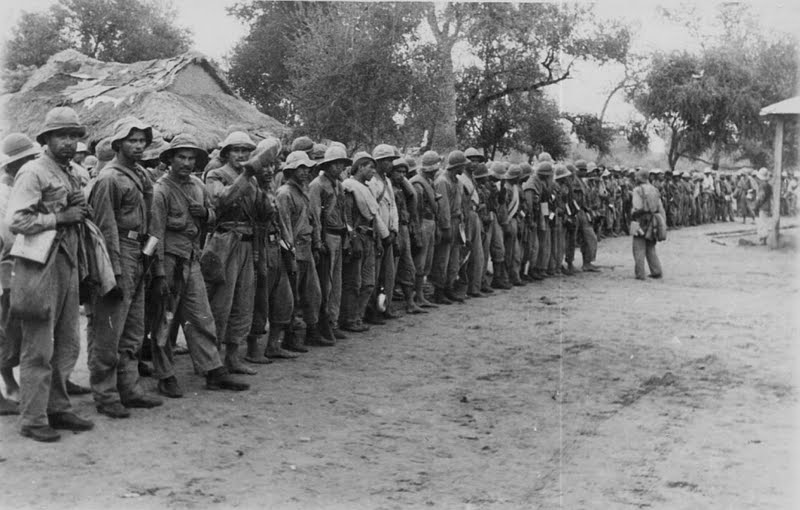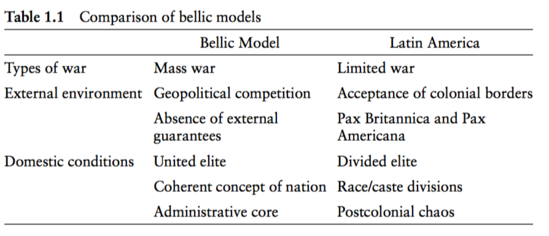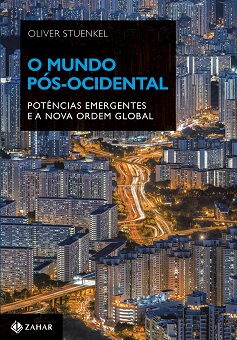
Book review: Blood and Debt: War and the Nation State in Latin America. By Miguel Angel Centeno. Penn State University Press, 2002. 344 pages. $18.69 (kindle, amazon.com)
——
At a recent policy debate about the future of global affairs, a speaker showed a map of global “hot spots”, pointing to regions he believed would be particularly prone to the outbreak of interstate war in the coming decade — large swaths of Africa, the Middle East and Asia, as well as Eastern Europe carried the symbol of small explosions to symbolize risk. It was a typical, though often overlooked, moment where South America stands out positively as one of the few continents with extremely low risk of interstate war. Indeed, with only a few exceptions, the region experienced peace throughout the 20th century, quite an achievement considering what happened elsewhere. Why are wars so unlikely in South America, and why have they occurred so rarely throughout history that scholars speak of a “long peace” in region?
That matters not only international affairs, but for the role of the state in Latin America as well. After all, from the ‘classic’ standpoint, built upon a stylized model of European state-building, war forces states to enhance their capacities, and is thus a crucial ingredient to explain the rise of modern, highly functional institutions — as the saying goes, “War is the parent of the modern nation state”, or, “War makes states, and states make war.” Those states that fail to extract resources from society are eliminated along the way.
However, this widely accepted model clearly fails to apply to Latin America, Miguel Angel Centeno observes in Blood and Debt, pointing out that the region’s national borders today are quite similar to those in the mid 19th century. Unlike European history, which saw the elimination of states like Poland or Saxony, no Latin American state ceased to exist.
What have been the consequences of peace for Latin America? States in Latin America are comparatively weak, failing in various degrees to provide basic services, obtain legitimacy, establish institutional autonomy, monopolize the use of force, and create a common physical space. Would bloodshed earlier and in a more decisive fashion have produced stronger, more cohesive, and more equitable states? Would the class divisions that permeate these societies have survived long conflicts? Has peace cost more than war?
The major difference between Europe and Latin America, Centeno argues, is that conflicts in Latin America were not total wars (which allow states to centralize and transform the relationship citizens have to the state), but limited wars, which offer far fewer transformative opportunities. The author argues that “limited wars rarely leave positive institutional legacies and often have long-term costs. Instead of producing states built on ‘‘blood and iron,’’ they generated states made of blood and debt — without being able to increase their capacity to collect taxes. It is precisely this latter pattern that we may observe in Latin America.” Rather than building nation-states and fostering democratic citizenship, he shows, war in Latin America destroyed institutions, confirmed internal divisions, and killed many without purpose or glory.
The enemy within
The Latin American wars, the author notes, were not long or threatening enough to allow national institutions to override class-based interests. Latin America lacks the monuments to ‘‘our glorious dead’’ that are ubiquitous in the landscape of Europe and the United States. The limited international struggles that occurred could not overcome internal divisions. The state and dominant elites in almost all countries in the region also appeared to prefer passive populations, thus avoiding steps like mass conscription. A too active or fervent sense of nationhood could actually backfire and create conditions inimical to continued elite domination, Centeno stresses: ”The very fact that the military was at least perceived as a ladder for social and ethnic mobility made its role as a national unifier problematic.” The result is that Latin American nations generally lacked the ability to fight one another more seriously. Conversely, domestic conflict often reflected the inability of the nascent states to impose their control over the relevant societies.
The enemy, as defined by state elites, was thus within, defined racially, along class lines, and by critical ideological struggles. Centeno even suggests there is a negative correlation between international bellicosity and internal violence — Chile, enjoying the most tranquil domestic scenario, engaged in international conflict most frequently, while Colombia and Mexico, torn apart by internal conflict, have not seen interstate warfare for over a century.
Paraguay may be an exception. In the nineteenth century, the country created a short-lived spell of homogeneity and autonomy, but this special feat ended with the outbreak of South America’s most sustained and bloody international conflict: the Paraguayan War (1864-70), fought between Paraguay and the united forces of Argentina, Brazil, and Uruguay. This experience had an important impact on daily life. In Paraguay, references to former military leaders are far more frequent until today, as any visitor can attest,
Internal societal structures, of course, are only part of the story. Centeno acknowledges that physical constraints — inhospitable border terrains such as the Amazon or the Andes and enough space to create buffer states such as Uruguay — also explain the low incidence of conflicts. More innovative is Centeno’s analysis of military journal articles which show little debate about potential interstate wars in the region. The author also suggests that Latin American militaries are generally ill-equipped to fight prolonged conflicts, lacked the access to resources required for anything beyond limited border clashes. Centeno’s book was published more than a decade ago, and in Colombia’s case (in the context of Plan Colombia) and Venezuela (due to large-scale purchases of Russian weapons, including Sukhoi fighter jets) this has changed somewhat. However, the assertion that no Latin American country currently possesses the capacity to sustain complex and drawn out wars remains valid. Cuba, Centeno argues, “is precisely the exception that proves the rule, as it has achieved a permanent mobilization of society that is alien to the Latin American political tradition.”

Paraguayan soldiers during the Chaco War (1932-1935)
All that does not mean that Latin American states would be stronger and more capable today had they experienced total war. Rather, wars merely provide a potential stimulus for state growth. Precisely in the period of its history when Latin America was most bellicose, the state was still struggling to establish its authority. The relevant model for Latin American states, the author suggests, is much more that of Austria-Hungary than of Prussia, which grew more sophisticated through war. Indeed, the forms of Latin American states with the most characteristics associated with ‘‘modern’’ political institutions (extensive bureaucracies, closer interaction with larger parts of the population) did not appear until the 1930s and 1940s under corporate and populist guises and were hardly influenced by the kind of geopolitical competition supposedly responsible for European development.
Here, Centeno makes a point that is of interest to a far wider spectrum of readers, pointing out that accepted theories place too much emphasis on European history, not considering that the case of Europe may be far too specific to create ‘general theories’. Indeed, the author suggests that the Latin American example may be helpful when studying war and state development in other regions in the developing world, such as Africa. Europe, by contrast, has been exceptional not only in the immense amount of organized violence that has characterized continental geopolitics, but also in enjoying preconditions that allowed it to transform this bloodshed into modern political institutions.
While Prussia, Muscovy and Piedmont needed war to centralize power over what would later become Germany, Italy or Russia, Latin American countries already possessed the territory, but struggled to occupy the formally defined nation. Wars not only helped little in this enterprise, but they were counterproductive.
The book’s second part is equally interesting, as Centeno uses data such as tax receipts, naming of streets and public monuments, and conscription records to examine how war affected the fiscal development of the state, the creation of national identity, and claims to citizenship. It is a fascinating study that underlines the importance for social scientists not to use a purely European perspective to study political development around the world. Despite the many problems Latin America currently faces, including the highest homicide rates in the world, Centeno’s analysis leaves us with at least some good news: Interstate war in the region will continue to be highly unlikely.
Read also:
Latin America confronts the United States
US Military Bases, Quasi-bases, and Domestic Politics in Latin America









